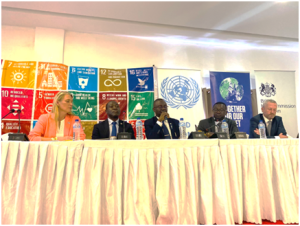By Foday Moriba Conteh
In the run-up to COP 27, the Government of Sierra Leone (GoSL) has on Thursday 13th October, 2022 joined co-hosts, the UK, EU and the UN Sierra Leone along with actors from across society for a Climate Action Dialogue. The meeting was focused on financing urgent climate action to safeguard national environmental resources for future generations as a growing part of national development planning.
Key speakers present at the ceremony included the Minister of Planning and Economic Development, Minister of Environment, Minister of Finance, UN Resident Coordinator, UK High Commissioner, and EU Development Director.
Sierra Leone is gearing up plans to access international climate financing but remains behind its regional neighbours. Participants explored how to advance this goal and enhance climate finance for Sierra Leone. The Dialogue explored on-going projects including in forest conservation, coastal management and cocoa cultivation as case studies for generating ‘carbon credits’ which can be traded on international markets to generate revenue. Well-conceived projects can not only mitigate climate impacts on the environment, but can also create income, provide jobs, enhance food security, and reduce disease risk.
Sierra Leone updated its commitments to climate action at the COP26 conference hosted by the UK in Glasgow in November 2021. The Government of Sierra Leone’s climate plan outlines how it will better prepare for climate crises and keep Greenhouse Gas emissions low. GoSL also agreed to end deforestation by 2030 as a signatory to the International Declaration on Forest and Land Use.
During the dialogue, participants agreed on the crucial next steps related to finance models to advance climate action. For example, a training workshop on accessing international carbon credit markets was planned.
Sierra Leone is highly vulnerable to the impact of climate change. This can already be seen as the dry season gets hotter and the rains get heavier. Extreme weather increases the risk of flooding, mudslides and crop failure. In turn this increases food insecurity, damages buildings and causes loss of life. The good news is that there are opportunities for Sierra Leone to limit those impacts and they can also provide jobs and new incomes as well as provide better access to food and safe water.
Sierra Leone’s wealth of forests, mangroves and other natural resources are its first line of defence against climate change. For Sierra Leone’s nature to protect people, people need to protect nature. When we damage our natural defences, for example deforesting steep slopes or polluting rivers, we put ourselves at risk. Sierra Leone has already suffered from mudslides and flooding which have cost precious lives, livelihoods and money.
At the same time, Sierra Leone has good potential for renewable and low carbon energy projects, like solar and hydro. These require important initial investments, but are cheaper in the long-run, reducing dependency on expensive imported energy (the source of high fuel costs today) and creating less pollution which protects our health and the environment around us.
We’re already seeing the impact of clean energy through the UK Aid funded Rural Electrification Programme (RESL) in support of the Government’s ambition to expand access to energy in rural areas. By the end of RESL implementation this year, Sierra Leone will have roughly 20% of Africa’s mini grids. Investments into climate-smart agriculture will also support food security, ensuring crops are more resistant to weather changes.
Completing the Government’s climate plan requires significant financial and technical assistance, including dependable streams of international climate finance. Of the 17 countries in West Africa, Sierra Leone received the second lowest pot of multilateral climate funds between 2003 and 2019.
Proposals for funding through these funds are often complex and lengthy, requiring technical expertise and special accreditation. The Dialogue was an important step to de-mystify access to vital climate finance, including the $100bn pledged to implement climate commitments made at COP26.
Beyond donor financing, Sierra Leone could consider trading ‘carbon credits’ with higher emitting countries, meaning Sierra Leone receives payments for protecting and restoring natural assets (e.g. reducing deforestation) in exchange for the other country claiming a reduction in its national emissions. The benefits for Sierra Leone include helping people adapt and build resilience to climate shocks, enhancing job creation and increasing access to food.
This is already working for UK sustainable forestry company, Miro Forestry. Miro uses carbon credits to provide additional returns for investors, the community and the country as a whole, while employing over 1000 people and bringing tax revenue so that GoSL can fund basic services across Salone. Clean energy like solar and hydro can also benefit from carbon credits, while increasing reliable, affordable electricity to power Sierra Leone’s sustainable development.
Carbon credits can catalyse scale-ups of payment for ecosystem services. This was recently confirmed by a prefeasibility study on ‘Blue Carbon’ potential from the mangrove forest in the Sherbro area, which was jointly sponsored by the EU and the Conservation Trust Fund. Countries such as Costa Rica have done this, starting in a similar situation to Sierra Leone with a tight government budget and high deforestation.
The EU is already promoting the development of payment schemes to ecosystem services by supporting Sierra Leone to protect the environment in some key ecological areas of the country, including the Outamba Kilimi and the Gola Forest National Parks.
The Ministry of Environment, the FAO and the EU are now discussing the implementation of a National Forest Monitoring System, as one of the first steps to make Sierra Leone ready for the REDD+ financing.







